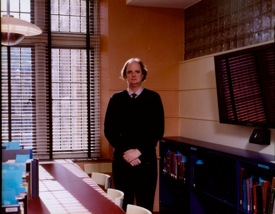Today’s post comes from Josh Schwartz, class of 2018 and Art Center Student Docent.

This semester, my drawing class is beginning to explore the figure. My teacher tends to show us a slideshow at the beginning of classes, a smorgasbord of different styles of figurative work by different artists. He swipes from photo to photo on his iPad while the images project in front of us, larger than life. The projections of these drawings remind me of the second room in XL: Large-Scale Paintings from the Permanent Collection, an exhibition devoted solely to oversized canvases. The second room features figurative work, and the people populating its walls are huge, seeming to loom out at the viewer from their frames.
Sandwiched between a room that explores the abstraction of nature and a room that displays gestural work, the figurative room seems to be the odd one out. It is the only room in the exhibition whose main concern isn’t abstraction. Although some figures in the room are abstracted, and their bodies are comprised of large, visible brush strokes, others are photorealistic, and others have a surrealist tinge. The room features the widest range of styles in the exhibit, but still links the two rooms surrounding it by proving that there are fewer differences between realism and abstraction than one might initially think.
One corner of the room includes Self-portrait by Alfred Leslie and Getting Ready for the Bath by Joan Brown. These two works seem like polar opposites. Brown uses large, expressive brushwork—you can almost imagine her putting the thick paint

down on the canvas. The face of her figure is blurred so that its features and expression are illegible. On the other hand, Leslie’s self-portrait ostensibly looks lifelike and fully realized. However, a closer read of the portrait brings certain details to light. For example, the earpieces of the figure’s eyeglasses are omitted and, although the figure appears to be wearing a tuxedo, the tiny amount of his pants visible shows that he is wearing jeans. Ultimately, Brown and Leslie choose to exclude and include certain details, borrowing from both life and from their imagination to portray their figures in a specific, intentional way.
My drawing teacher always says “drawing is seeing,” and, in this case, seeing multiple interpretations of a similar subject has allowed me to see that subject in a more nuanced way. Looking at both the gestural and realistic aspects of painting the figure and what those styles imply has given me a new way of seeing the figure.




